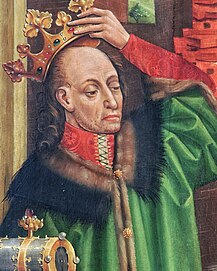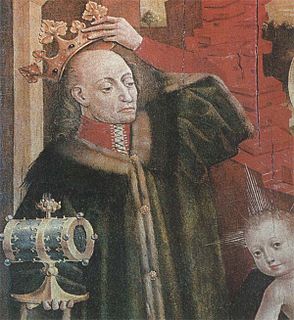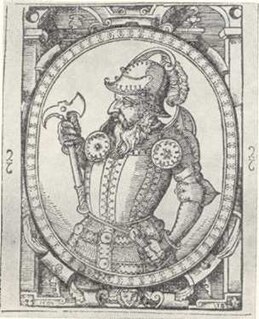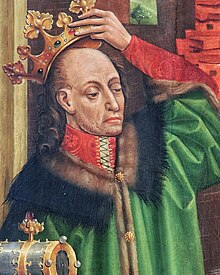
Jogaila, later Władysław II Jagiełło was the Grand Duke of Lithuania (1377–1434) and then the King of Poland (1386–1434), first alongside his wife Jadwiga until 1399, and then sole King of Poland. He ruled in Lithuania from 1377. Born a pagan, in 1386 he converted to Catholicism and was baptized as Władysław in Kraków, married the young Queen Jadwiga, and was crowned King of Poland as Władysław II Jagiełło. In 1387 he converted Lithuania to Christianity. His own reign in Poland started in 1399, upon the death of Queen Jadwiga, and lasted a further thirty-five years and laid the foundation for the centuries-long Polish–Lithuanian union. He was a member of the Jagiellonian dynasty in Poland that bears his name and was previously also known as the Gediminid dynasty in the Grand Duchy of Lithuania. The dynasty ruled both states until 1572, and became one of the most influential dynasties in late medieval and early modern Central and Eastern Europe. During his reign, the Polish-Lithuanian state was the largest state in the Christian world.

Švitrigaila was the Grand Duke of Lithuania from 1430 to 1432. He spent most of his life in largely unsuccessful dynastic struggles against his cousins Vytautas and Sigismund Kęstutaitis.

Kęstutis was a ruler of medieval Lithuania. He was the Duke of Trakai and governed the Grand Duchy of Lithuania, 1342–1382, together with his brother Algirdas, and with his nephew Jogaila. He ruled over the Lithuanians and Ruthenians.

The (First) Peace of Thorn was a peace treaty formally ending the Polish–Lithuanian–Teutonic War between allied Kingdom of Poland and Grand Duchy of Lithuania on one side, and the Teutonic Knights on the other. It was signed on 1 February 1411 in Thorn (Toruń), one of the southernmost cities of the Monastic State of the Teutonic Knights. In historiography, the treaty is often portrayed as a diplomatic failure of Poland–Lithuania as they failed to capitalize on the decisive defeat of the Knights in the Battle of Grunwald in June 1410. The Knights returned Dobrzyń Land which they captured from Poland during the war and made only temporary territorial concessions in Samogitia, which returned to Lithuania only for the lifetimes of Polish King Władysław Jagiełło and Lithuanian Grand Duke Vytautas. The Peace of Thorn was not stable. It took two other brief wars, the Hunger War in 1414 and Gollub War in 1422, to sign the Treaty of Melno that solved the territorial disputes. However, large war reparations were a significant financial burden on the Knights, causing internal unrest and economic decline. The Teutonic Knights never recovered their former might.

The Polish–Lithuanian–Teutonic War or Great War occurred between 1409 and 1411, pitting the allied Kingdom of Poland and Grand Duchy of Lithuania against the Teutonic Knights. Inspired by the local Samogitian uprising, the war began by Teutonic invasion of Poland in August 1409. As neither side was ready for a full-scale war, Wenceslaus IV of Bohemia brokered a nine-month truce. After the truce expired in June 1410, the military-religious monks were decisively defeated in the Battle of Grunwald (Tannenberg), one of the largest battles in medieval Europe. Most of the Teutonic leadership was killed or taken prisoner. While defeated, the Teutonic Knights withstood the siege on their capital in Marienburg (Malbork) and suffered only minimal territorial losses in the Peace of Thorn (1411). Territorial disputes lasted until the Peace of Melno of 1422. However, the Knights never recovered their former power and the financial burden of war reparations caused internal conflicts and economic decline in their lands. The war shifted the balance of power in Central Europe and marked the rise of the Polish–Lithuanian union as the dominant power in the region.

The Treaty of Melno or Treaty of Lake Melno was a peace treaty ending the Gollub War. It was signed on 27 September 1422, between the Teutonic Knights and an alliance of the Kingdom of Poland and the Grand Duchy of Lithuania at Lake Melno, east of Graudenz (Grudziądz). The treaty resolved territorial disputes between the Knights and Lithuania regarding Samogitia, which had dragged on since 1382, and determined the Prussian–Lithuanian border, which afterwards remained unchanged for about 500 years. A portion of the original border partially survives as the border between the Republic of Lithuania and Kaliningrad Oblast, Russia, making it one of the most stable borders in Europe.

The Gollub War was a two-month war of the Teutonic Knights against the Kingdom of Poland and the Grand Duchy of Lithuania in 1422. It ended by signing the Treaty of Melno, which resolved territorial disputes between the Knights and Lithuania over Samogitia that had dragged on since 1398.
The Treaty of Königsberg was signed in Königsberg(Królewiec) on May 26, 1390 during the Lithuanian Civil War (1389–1392) between Samogitian nobles and representatives of the Teutonic Knights. The 31-member or 30-member delegation from seven Samogitian regions arrived to Königsberg around the pentecost. They promised their loyalty to "their king" Vytautas and guaranteed trade freedom for the Knights in Samogitia. The Knights gifted the nobles with food and clothes.

The Ostrów or Astrava Agreement was a treaty between Jogaila, King of Poland and Grand Duke of Lithuania, and his cousin Vytautas the Great, signed on 4 August 1392. The treaty ended the destructive Lithuanian Civil War, launched in 1389 by Vytautas who hoped to gain political power, and concluded the power struggle between the two cousins that erupted in 1380 after Jogaila secretly signed the Treaty of Dovydiškės with the Teutonic Knights. The Ostrów Agreement did not stop attacks from the Teutonic Knights and the territorial dispute over Samogitia continued up to 1422. According to the treaty, Vytautas became the ruler of Lithuania, but he also acknowledged Jogaila's rights to Lithuania. The details of the Polish–Lithuanian relationship were clarified in several later treaties, including the Union of Vilnius and Radom in 1401 and Union of Horodło in 1413.

Treaty of Salynas was a peace treaty signed on 12 October 1398 by the Grand Duke of Lithuania Vytautas the Great and the Grand Master of the Teutonic Knights Konrad von Jungingen. It was signed on an islet of the Neman River, probably between Kulautuva and the mouth of the Nevėžis River. It was the third time, after the Treaty of Königsberg (1384) and Treaty of Lyck (1390), that Vytautas promised Samogitia to the Knights. The territory was important to the Knights as it physically separated the Teutonic Knights in Prussia from its branch in Livonia. It was the first time that the Knights and Vytautas attempted to enforce the cession of Samogitia. However, it did not solve the territorial disputes over Samogitia and they dragged on until the Treaty of Melno in 1422.
Vygantas was Duke of Kernavė. He was one of the sons of Algirdas, Grand Duke of Lithuania (1345–1377), and his second wife Uliana Alexandrovna of Tver.
The Treaty of Dubysa or Treaty of Dubissa consisted of three legal acts formulated on 31 October 1382 between Jogaila, Grand Duke of Lithuania, with his brother Skirgaila and Konrad von Wallenrode, Marshal of the Teutonic Order. During the Lithuanian Civil War (1381–84), Teutonic Order helped Jogaila and Skirgaila to defeat their uncle Kęstutis and his son Vytautas. Trying to realize promises given by Jogaila during the war, Teutonic Order organized the negotiations for the treaty. The acts were signed after six days of negotiations on an island in the mouth of the Dubysa River. The treaty was never ratified and never came into effect. The civil war resumed in summer 1383.
Karigaila was a son of Algirdas, Grand Duke of Lithuania, and his second wife Uliana of Tver. He became the ruler of Mstsislaw after he captured it from the Principality of Smolensk. He is sometimes mistaken for his brother Constantine, who was the founder of the House of Czartoryski.

The Lithuanian Civil War of 1381–1384 was the first struggle for power between the cousins Jogaila, Grand Duke of Lithuania and later King of Poland, and Vytautas the Great. It began after Jogaila signed the Treaty of Dovydiškės with the Teutonic Knights which was aimed against his uncle Kęstutis, father of Vytautas. Kęstutis briefly seized power in the Grand Duchy, but was betrayed by adherents of Jogaila primarily from Vilnius. During negotiations for a truce Kęstutis and Vytautas were arrested and transported to the Kreva Castle. Kęstutis died there a week later but Vytautas managed to escape and then sought an alliance with the Teutonic Knights. Subsequently their joint forces raided Lithuanian lands. Eventually the cousins were reconciled as Jogaila needed internal stability in anticipation of negotiations with the Grand Duchy of Moscow and the Kingdom of Poland regarding the possible Christianization of Lithuania. The war did not settle the power struggle; it continued during the next Lithuanian Civil War (1389–1392) which was resolved by the signing of the Ostrów Agreement. After more than ten years of struggle, Vytautas finally became the Grand Duke of Lithuania and ruled the country for thirty-eight years.
The Treaty of Königsberg was signed in Königsberg (Królewiec) on 30 January 1384, during the Lithuanian Civil War (1381–1384) between Vytautas the Great and representatives of the Teutonic Knights. Vytautas waged a civil against his cousin Jogaila, Grand Duke of Lithuania and future King of Poland, and allied himself with the Teutonic Knights. In order to secure Teutonic support in the civil war, Vytautas signed the treaty and granted Samogitia up to the Nevėžis River and Kaunas to the Knights. In 1382 Jogaila promised the Knights Samogitia only up to the Dubysa River, but never ratified the Treaty of Dubysa. Samogitia was important for the Knights as this territory physically separated them from uniting with the Livonian order in the north. Vytautas also promised to become Order's vassal. In February several Samogitian regions acknowledged their support to Vytautas and the Knights.

Peace of Raciąż was a treaty signed on 22 May 1404 between Kingdom of Poland, Grand Duchy of Lithuania, and the Teutonic Knights, regarding the control of the Dobrzyń Land and Samogitia. Poland in essence confirmed the Treaty of Kalisz of 1342 and Lithuania – the Treaty of Salynas of 1398. The treaty was not stable and the situation soon changed with the Polish-Lithuanian–Teutonic War of 1409–1411.

Samogitian uprisings refer to two uprisings by the Samogitians against the Teutonic Knights in 1401–1404 and 1409. Samogitia was granted to the Teutonic Knights by Vytautas the Great, Grand Duke of Lithuania, several times in order to enlist Knights' support for his other military affairs. The local population resisted Teutonic rule and asked Vytautas to protect them. The first uprising was unsuccessful and Vytautas had to reconfirm his previous promises to transfer Samogitia in the Peace of Raciąż. The second uprising provoked the Knights to declare war on Poland. Hostilities escalated and resulted in the Battle of Grunwald (1410), one of the biggest battles of medieval Europe. The Knights were soundly defeated by the joint Polish–Lithuanian forces, but Vytautas and Jogaila, King of Poland, were unable to capitalize on their victory. Conflicts regarding Samogitia, both diplomatic and military, dragged until the Treaty of Melno (1422).



























